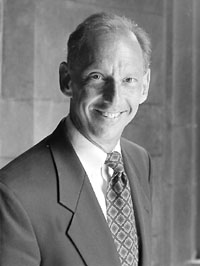
Alan E. Kazdin
|
There are 550 different therapeutic techniques for treating children with emotional problems, but a new book by a Yale psychologist says little is known about what works, why and for whom.
Knowing what works is important because 10 percent of all 3-to 17-year-olds -- or about seven million children -- receive treatment for emotional or behavioral problems, says psychology professor Alan E. Kazdin, whose book, "Psychotherapy for Children and Adolescents," is being published by Oxford University Press this month.
In the early 1960s, there were about 60 different types of psychotherapy. In the 1970s, the figure rose from 130 to more than 250 techniques. By the mid-1980s, there were over 400 techniques, said Kazdin, director of the Yale Child Conduct Clinic, in his book.
"The number of techniques continues to expand -- sort of like a Big Bang theory of psychotherapy," he says. "The difficulty is that the vast majority of these techniques have never been studied, and we have no idea whether they help, hinder or have no impact on the clinical problems to which they are applied. The questions should be posed by researchers to whom we look for answers that can't be answered in the practice."
Little is known about how different techniques result in change because of the way treatment research is conceptualized, says the psychologist. Also, the investigations are limited, he contends, and there is no blueprint or long-range plan to answer questions about child treatment.
As the number of treatments has ballooned, so has the list of symptoms, maladaptive behaviors, target complaints and dysfunction now recognized as clinical problems, Kazdin says. The most recent edition of the American Psychiatric Association's Diagnostic and Statistical Manual of Mental Disorders, published in 1994, includes over 300 recognized diagnoses and disorders -- up from 100 in 1952, he notes.
The problems range from learning disorders to depression and substance abuse problems. The approaches to treatment might include psychoanalytic, behavioral, cognitive, experiential, existential/humanistic, or integrative-eclectic, to name only a handful, explains the psychologist.
Evaluating the effects of the 550 techniques on each of the 300 disorders, including the comparison of treatments and evaluation with different types of children and families, would require several million studies, contends Kazdin.
His book proposes alternative studies, outlines the questions they will answer, and explains how the studies will yield answers for therapists.
Kazdin's studies would use a system of moderators and mediators. A moderator is a variable that influences the relationship between two or more other variables for example, how the effects of treatment "A" may differ for boys and girls. A mediator is the means through which a variable operates or produces a particular outcome.
He said that under his proposed system, researchers will ask new questions and have new ways of looking for answers.
"There has been no concerted effort to understand why people change and how people change," Kazdin said. "For instance, we know that religion, exercise, hypnosis, chatting with a friend, writing things on paper, all of these things bring about change. But we don't know how. With this new research, we will find out why people change."
-- By Jacqueline Weaver
T H I S
Bulletin Home
 W E E K ' S
W E E K ' S S T O R I E S
S T O R I E S![]()
 Levin cited for community leadership
Levin cited for community leadership![]()
![]()
 Study reveals benefits of new prostate cancer therapy
Study reveals benefits of new prostate cancer therapy
![]()
![]()
 Grant to fund national test of new teaching method
Grant to fund national test of new teaching method![]()
![]()
 Expert on care of minority elders receives nursing field's top honor
Expert on care of minority elders receives nursing field's top honor![]()
![]()
 Alumni Whiffenpoofs will reunite for 90th musical 'spree'
Alumni Whiffenpoofs will reunite for 90th musical 'spree'![]()
![]()
 Perspectives on Richard Levin
Perspectives on Richard Levin![]()
![]()
 Psychologist Kazdin proposes new way to assess the effectiveness of therapies for youngsters
Psychologist Kazdin proposes new way to assess the effectiveness of therapies for youngsters![]()
![]()
 Scientists' find vastly enhances computer memory
Scientists' find vastly enhances computer memory![]()
![]()
 Library gets grant to preserve rare films from Yale's past
Library gets grant to preserve rare films from Yale's past![]()
![]()
 Yale Art Gallery exhibit traces key themes in American art and design across four centuries
Yale Art Gallery exhibit traces key themes in American art and design across four centuries![]()
![]()
 Museum joins U.S.-French consortium
Museum joins U.S.-French consortium![]()
![]()
 Marks is new director of Pierson Lab
Marks is new director of Pierson Lab![]()
![]()
 Karl M.Waage, renowned for his geological discoveries, dies
Karl M.Waage, renowned for his geological discoveries, dies![]()
![]()
 Yale scientists to speak at NAS symposium on campus
Yale scientists to speak at NAS symposium on campus![]()
![]()
 Symposium on global climate change marks anniversary of landmark report
Symposium on global climate change marks anniversary of landmark report![]()
![]()
 Reading to feature letters of Revolutionary War partners
Reading to feature letters of Revolutionary War partners![]()
![]()
 U.S. national identity will be topic of talk by noted writer
U.S. national identity will be topic of talk by noted writer![]()
![]()
 Wrap up your holiday shopping at one-day event
Wrap up your holiday shopping at one-day event![]()
![]()
 And the winners are...
And the winners are...![]()
![]()
 Chinese delegates
Chinese delegates![]()
![]()
 . . . In the News . . .
. . . In the News . . .![]()
![]()
 Campus Notes
Campus Notes![]()
 |
| Visiting on Campus
Visiting on Campus |
| Calendar of Events
Calendar of Events |
| Bulletin Board
Bulletin Board![]()
Classified Ads |
| Search Archives
Search Archives |
| Production Schedule
Production Schedule |
| Bulletin Staff
Bulletin Staff![]()
Public Affairs Home |
| News Releases
News Releases |
| E-Mail Us
E-Mail Us |
| Yale Home Page
Yale Home Page